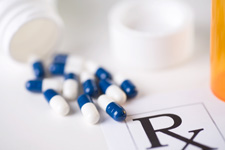[column]
Learning outcomes
Level 1 case study: You will be able to:
- describe the risk factors
- describe the disease
- describe the pharmacology of the drug
- outline the formulations available, including drug molecule, excipients, etc. for the medicines
- summarise basic social pharmacy issues (e.g. opening containers, large labels).
Scenario
Mr AG, a 57-year-old taxi driver of Indian origin, attends your community pharmacy with a new prescription for: glyceryl trinitrate (GTN) spray 400 micrograms – one or two puffs as required. You dispense this item and speak with him and he tells you that his GP thinks he has angina and has asked him to use the spray the next time he gets any minor chest pain or tightness. You counsel Mr AG on the correct use of the spray.
Mr AG returns a few days later complaining of a headache following the use of the spray. He is reluctant to use the spray again. He asks your advice on managing his headache. He also smokes about five cigarettes a week and asks if he should now stop.
1a. What is angina?
1b. What typical symptoms could a patient with angina present with?
2a. What are the risk factors for developing angina?
2b. What, if any, risk factors does Mr AG have for developing stable angina?
3a. What group of drugs does GTN spray belong to?
3b. What are the side-effects of GTN spray?
3c. How would you counsel Mr AG on the use of his spray?
3d. What other formulations of GTN are available? List their advantages and disadvantages.
4. Mr AG’s headache may be caused by his use of GTN spray. What can you recommend to him to help manage his headache?
5. What advice would you give Mr AG in relation to his smoking?
Answers:
1a What is angina?
Angina pectoris describes the classic symptoms of chest pain, and is caused by transient myocardial ischaemia. In stable angina, the blood flow through the coronary arteries may be limited due to the development of atherosclerotic plaques that restrict blood and therefore oxygen to the cardiac muscle myocardium. Episodes of angina are typically caused by exertion or emotion and are relieved by rest.
1b What typical symptoms could a patient with angina present with?
Central chest tightness or heaviness, which may be brought on by exertion or relieved by rest. It may radiate to one or both arms, the neck, jaw or teeth. Other associated symptoms include: dyspnoea (shortness of breath), nausea, sweatiness and faintness.[/column]
2a What are the risk factors for developing angina?
Modifiable risk factors (those that we can do something about) for angina and ischaemic heart disease include:
- hyperlipidaemia
- smoking
- hypertension
- lack of exercise
- poor diet
- personality
- obesity
- heavy alcohol consumption
- contraceptive pill
- stress.
Non-modifiable risk factors (those we cannot change) include:
- age
- gender
- positive
- family history
- diabetes mellitus
- ethnicity.
2b What, if any, risk factors does Mr AG have for developing stable angina?
- Age
- Indian origin
- Sedentary job/possible lack of exercise
- Smoking
- Gender – men are at increased risk.
3a What group of drugs does GTN spray belong to?
GTN is a nitrate. This class of drugs are potent vasodilators. At therapeutic doses the main effect of nitrates is to act on vascular smooth muscle to dilate the veins, thus reducing central venous pressure (preload) and ventricular end- diastolic volume. The overall effect is to lower myocardial contraction, wall stress and oxygen demand, thereby relieving the angina. Nitrates also promote vasodilation of the coronary blood vessels.
3b What are the side-effects of GTN spray?
- Postural hypotension
- Tachycardia
- Throbbing headache
- Dizziness
- Less commonly – nausea, vomiting, heartburn, flushing.
3c How would you counsel Mr AG on the use of his spray?
The patient should be instructed to:
- remove the cap and to hold the spray upright (vertically),
- prime the spray before using for the first time,
- spray one or two sprays under the tongue and close the mouth immediately afterwards, and
- sit down and rest until the pain subsides.[end_columns]
3d What other formulations of GTN are available? List their advantages and disadvantages.
| Formulation | Advantages | Disadvantages |
| 1. GTN sublingual tablets 300 micrograms or 500 micrograms | Rapid onset (<30 seconds) Cheap | Chemical degradation occurs, hence discard 8 weeks after first opening Headache and dizziness common |
| 2. GTN spray 400 micrograms | Rapid onset (<30 seconds) Long expiry date (years) compared to sublingual tablets | More expensive than tablets Headache and dizziness common |
| 3. GTN patches | Useful as longer duration of action | Skin reactions may occur, although uncommon (between 0.1 and 1%) Headache and dizziness common |
| 4. GTN buccal tablets | Rapid onset but slightly slower than sublingual tablets (see 1 above) | Headache and dizziness common |
| 5. GTN injection | Dose by infusion can be carefully controlled and titrated against chest pain in acute situations | Not suitable for day-to-day use as injection – only for acute situations (e.g. unstable angina) Requires careful dilution and use of specific types of syringes and infusion lines |
[column]4 Mr AG’s headache may be caused by his use of GTN spray. What can you recommend to him to help manage his headache?
Check how Mr AG is using his spray in the first instance. The correct approach is at the onset of an attack or prior to a precipitating event: one or two 400- micrograms metered doses sprayed under the tongue. It is recommended that no more than three metered doses are taken at any one time and that there should be a minimum interval of 15 minutes between consecutive treatments. For the prevention of exercise-induced angina or in other precipitating conditions one or two 400-micrograms metered doses should be sprayed under the tongue immediately prior to the event. Mr AG can be advised to take paracetamol up to 4 g daily (i.e. one or two 500 mg tablets, every 4–6 hours; maximum eight tablets per 24 hours) to relieve his headache. If the headache persists or is severe he should arrange to see his GP to discuss his treatment. [/column]
5 What advice would you give Mr AG in relation to his smoking?
Anyone with angina who smokes should be advised to stop. Smokers have a higher incidence of ischaemic heart disease, and a greater risk of dying from it. The greater the number of cigarettes smoked, the greater the risk. Nicotine- replacement therapy can be recommended as part of a smoking cessation programme in people with angina. (Case study level 1–Angina, completed) [end_columns]
General references
- Clinical Knowledge Summaries (2003) Angina. Available: http://www.prodigy.nhs.uk/ angina [Accessed 23/10/06].
- Joint Formulary Committee (2008) British National Formulary 55. London: British Medical Association and Royal Pharmaceutical Society of Great Britain, March.
- Nitrolingual Pump Spray, Summary of Product Characteristics. Available at http://emc. medicines.org.uk/ [Accessed 3 July 2008].
Author: Narinder Bhalla; BSc (Hons), MSc, MRPharmS. Pharmacist,Cambridge University Hospital.







